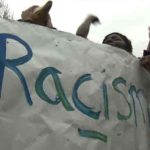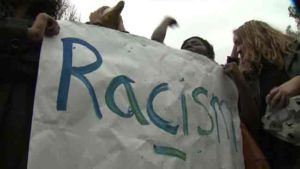
Swastikas, nooses, a KKK-style hood, and a student-run TV show featuring offensive racial epithets: An ugly spate of racially charged incidents has occurred across several University of California campuses over the past month, causing consternation, outcry, and fear that bigotry is alive and well among the young and educated.
Students have protested and administrators have condemned the actions, but the question remains: What lies behind the sudden parade of prejudice—a growing climate of insensitivity on campuses, or a bunch of immature kids yearning for peer acceptance and attention?
“My guess is some of all of those things,” said interim UC Provost Lawrence H. Pitts. “I’d like to believe it’s really an extreme minority. It does suggest there’s some underlying feeling of intolerance in our community.”
The incidents have roiled several campuses in the 175,000-student state university system, which is one of the nation’s most respected and diverse.
UC San Diego has halted funding for student media after a TV segment ridiculed black students outraged by a party mocking Black History Month last month.
The head of the school’s student government froze funding for several student media outlets after one, The Koala, ran a student TV episode calling black students ungrateful and using a derogatory term for blacks. He also pulled the student-run television station off the air.
Associated Students President Utsav Gupta suspended funding for about 15 of the school’s 33 student-funded media outlets to avoid the impression that he was judging content. He said Koala or any other outlet may continue to publish, just without student funding.
“Some students are drawing the incorrect conclusion that this is muzzling free speech,” he said in an interview. “The right to free speech does not equate to a right to funding.”
In a letter posted on a new university web site to address recent racially charged incidents on campus, Gupta said the organization “will only open [the TV station] again when we can be sure that such hateful content can never be aired again on our student-funded TV station.”
Gupta also pleaded for patience with other student media outlets until a committee can craft a new policy on student-funded media.
The Koala, which has a reputation for airing offensive material, made fun of reaction to an off-campus fraternity party Feb. 15 that urged partygoers to dress as ghetto stereotypes to commemorate Black History Month.
Gupta, who called the program “deeply offensive and hurtful,” said the segment aired without approval from the two station managers. That’s a violation of the student-run television charter, prompting him to pull the station off the air.
Since that incident, the campus has been stunned by two other racially charged incidents: A noose was found hanging in a campus library, and a white pillowcase fashioned into a KKK-style hood was found on a statue of children’s book author Theodor Geisel, also known as Dr. Seuss. A rose had been inserted between the statue’s fingers.
At UC Davis, swastikas cropped up and the gay and lesbian center was vandalized with graffiti. At UC Santa Cruz, a picture of a noose was scrawled. On the Irvine campus, the Israeli ambassador was heckled to the extent that he was forced to end a speech early.
The acts were particularly shocking because they occurred on university campuses—usually considered centers of intellectual enlightenment above acts commonly associated with ignorance.
But experts note that universities are microcosms of society at large, and that includes hate-mongers. Upticks in hate crimes are often seen in times of economic malaise as people seek scapegoats, noted Jack Levin, a Northeastern University sociologist who has studied hate.
Still, surveys show that prejudice among today’s young people is at a low and interracial and interethnic marriages are at an all-time high, said Tom Smith, director of the general social survey at the National Opinion Research Center. Studies have also long found that education increases tolerance of different groups, he added.
“College students, as a group, are quite liberal on this issue,” Smith said.
Minority students said that’s why they’re galled that fellow students today would even think that something like hanging a noose in a library is funny or acceptable. The UC San Diego school paper later published a letter of apology from a female student who wrote that she had only been playing with a rope, accidentally left in the library and did not mean to offend.
“Part of the problem is that people don’t realize it’s insensitive,” said Joelle Gamble, a student at the University of California, Los Angeles. “They see it as free speech.”
Free speech is a buzzword on college campuses, which tend to be regarded as “marketplaces of ideas” where students are encouraged to express opinions freely, said Brian Levin, director of Center for the Study of Hate and Extremism at California State University, San Bernardino.
But sometimes opinions can cross into offensiveness.
At UC Irvine, pro-Palestinian students saw the jeering of the Israeli Ambassador Michael Oren as a political statement, but administrators saw it as intolerance, albeit of a political viewpoint. Eleven students were arrested.
“This is a place where we would like to expose students to a wide a spectrum of the world as we can construct,” Provost Pitts said. “We have a very broad curve of human belief here. It’s a huge place. So it’s hurtful that this comes up.”
Experts point out that some racist incidents are likely sophomoric pranks as students cross the bridge from adolescence to adulthood.
Although students are expected to behave as adults, some still possess a teenager’s impulsiveness and desire to impress peers, which can lead to boorish behavior. Then there are the copycats who enjoy the ensuing uproar and media attention.
“It’s the Jackass phenomenon,” Cal State’s Levin said, referring to the popular MTV show that made entertainment out of shocking behavior—a trend that has been amplified by the infamy that web sites such as YouTube can bestow. “Most are not hard-core bigots, but some are.”
Levin and others note that bias incidents occur on campuses all over the country, and college hate crimes are likely vastly underreported.
UC Davis psychologist Gregory Herek said gay and lesbian students tell him they are regularly harassed. “The truth is there are many acts of intolerance,” he said. “This is a day-to-day experience.”
Whatever lies behind the bias incidents, university officials are stepping up efforts to make underrepresented groups feel more included on campus. UC San Diego, for one, is working with the Black Student Union to establish diversity curriculum requirements and recruit more minority students and faculty.
On March 5, UC President Mark Yudoff appointed a special adviser to assist UC San Diego on tolerance issues.
Pitts said chancellors will be evaluated on increases of student-body diversity. “This is a reminder,” he said, “this is a battle that’s never won.”
Links:
National Opinion Research Center
Center for the Study of Hate and Extremism
- Student programmers solve real-world challenges - July 12, 2010
- Computers make strides in recognizing speech - June 25, 2010
- On new iPhone, a mystery of dropped calls - June 25, 2010

